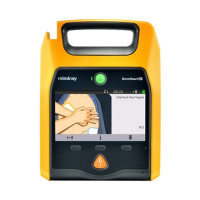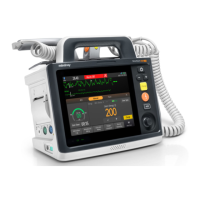Defibrillator/Monitor Operator’s Manual 5 - 1
5 Monitoring ECG
5.1 ECG Introduction
The electrocardiogram (ECG) measures the electrical activity of the heart and displays it as waveforms and
numerics. The equipment enables ECG monitoring through 3-lead ECG sets, 5-lead ECG sets, external paddles
and electrode pads. If both ECG sets and external paddles/electrode pads are connected, the configured ECG
waveforms are displayed in the waveform area.
ECG monitoring is intended for adult, pediatric and neonatal patients.
5.2 ECG Safety Information
• ECG monitoring is not suitable for direct cardiac application.
• Periodically inspect the electrode application site to ensure skin quality. If the skin quality changes,
replace the electrodes or change the application site.
• Use defibrillation-proof ECG cables during defibrillation.
• When monitoring a patient implanted with a pacemaker, be sure to select correct paced status.
Otherwise, the pace pulses may be counted in the case of cardiac arrest or some arrhythmias. Do not
completely rely on the heart rate reading or the heart rate alarms. Always keep paced patients under
close surveillance.
• PACEMAKER PATIENTS – On ventricular paced patients, episodes of Ventricular Tachycardia may not
always be detected. Do not rely entirely upon the system’s automated arrhythmia detection
algorithm.
• Interference from a non-grounded instrument near the patient and electrosurgery interference can
cause problems with the waveform.
• When connecting electrodes and/or patient cables, make sure that the connectors never come into
contact with other conductive parts, or with earth. Particularly make sure that all of the ECG
electrodes are attached to the patient.
• If selected lead cannot provide valid ECG signals, a dash line is shown in the ECG waveform area.
• Avoid using external paddles for ECG monitoring if possible.
• Use the same type of ECG electrodes when monitoring ECG through ECG lead set.

